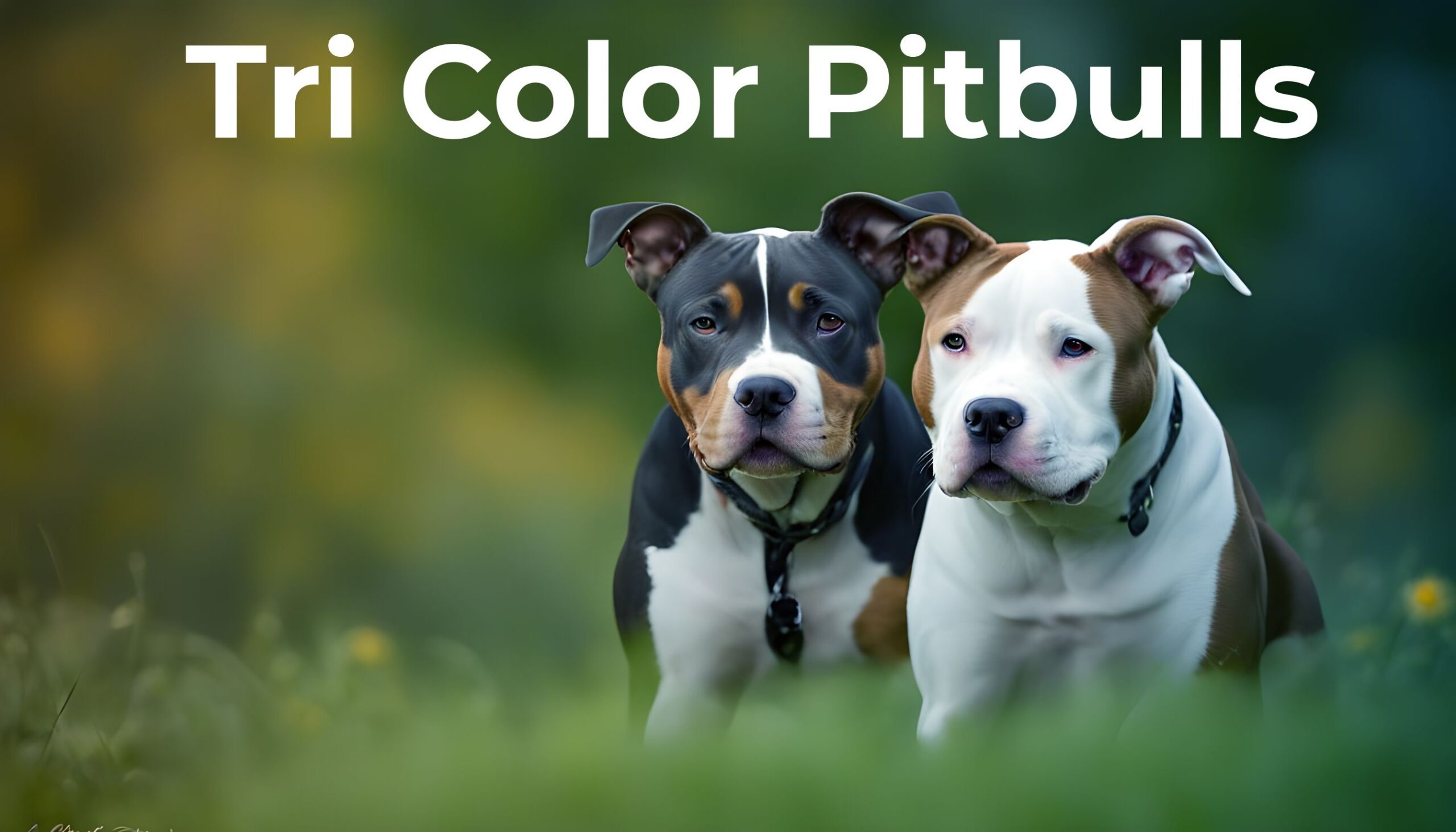In a world where loyalty wears a coat of many colors, there is a breed that captures hearts. Tri-color Pitbulls are special dogs with a different appearance and personality than regular dogs.
These dogs are so captivating that people from all walks of life are drawn to them. My journey with Tri-color Pitbulls has taught me the value of these dogs as loving and loyal companions.
In this article, we will explore what makes Tri color Pitbull so special. We’ll talk about its one-of-a-kind coat patterns and personality, which is so lovable.
Whether you’re already a big fan of Pitbulls or just starting to learn about dogs, we’re here to help you discover the enchanting world of Tri-Color Pitbulls.
Tri-Color Pitbull Quick Facts
| Trait | Description |
| Coat Colors | Striking Hues |
| Temperament | Loyal, Loving |
| Popularity | Rising Trend |
| Misconceptions | Unfair Stereotypes |
| Grooming | Low-Maintenance |
| Exercise Needs | Active Lifestyle |
| Lifespan | 10-15 years |
| Adoption | Rescues, Breeders |
| Training | Responsive |
| Price Range | $750- varies |
What Is a Tri-Color Pitbull?
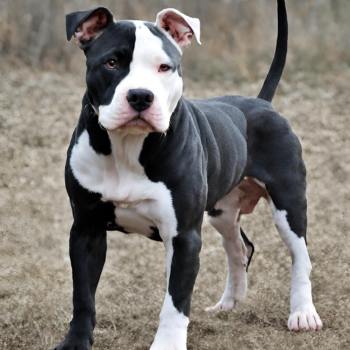
A Tri-Color Pitbull is a Pitbull with a coat of three colors.
Pitbulls are a type of dog originally bred for bull baiting and dog fighting. Today, Pitbulls are known for being loving and loyal companions.
Tri-color pit bulls are a distinct and captivating divergence of the American Pit Bull Terrier.
These dogs are known for their striking coat patterns, blending three colors: black, white, and brown.
The most common combination includes black, white, and tan, but other variations exist.
Each Tri-Color Pitbull possesses a unique and beautiful coat, making it stand out in the world of dog breeds.
Their striking appearance and loving nature make them wonderful pets for those willing to give them the care and attention they deserve.
Tri-Color Pitbull History and Origin
Tri-Color Pitbulls, while similar in many ways to other Pitbulls, are distinct due to the number of colors on their coat.
They originated in the early 1800s in the United Kingdom. This type of dog comes from mixing Old English Bulldogs and Terriers long ago. People made these dogs for jobs like fighting bulls, catching rats, and fighting bears.
As time passed, these brutal practices were banned in the UK in 1835. Dogfighting then gained popularity as a form of entertainment.
Between 1845 and 1860, as immigrants from the British Isles migrated to the United States, they brought their Pitbulls with them, leading to the emergence of the American Pit Bull Terrier breed.
However, the specific history of Tri-Color Pitbulls, with their striking coat patterns, remains somewhat mysterious.
Crossbreeding and selective breeding practices within the broader Pitbull lineage likely introduced the tan-point gene responsible for the Tri-Color pattern.
How the Tricolor Pitbull Gained Popularity?
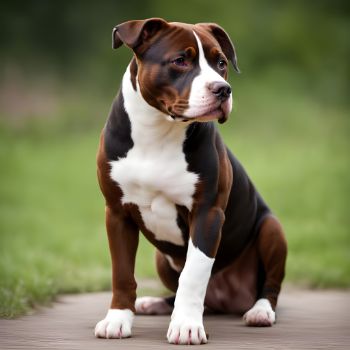
In the 19th century, Pitbulls, including those with tri-color patterns, played crucial roles in human life.
They were hardworking farm dogs, assisting in agriculture, herding cattle and sheep, and guarding livestock.
Beyond their role on the farm, they served as protectors of families and, notably, as guardians of children.
It earned them the endearing nickname “nanny dogs” because of their loving and protective nature.
Pitbulls proved to be reliable companions, and over time, they also found roles as therapy dogs and even in law enforcement.
In the past, breeders often avoided the tri-color pattern, as it was sometimes associated with the misconception of the breed being a hybrid.
However, over the past two decades, there has been a significant shift in the appeal of these dogs.
Today, breeders actively work to selectively breed different colors of pit bulls, including the tri-color pattern. It has led to a growing appreciation for the uniqueness and beauty of Tri-Color Pitbulls among breed enthusiasts and potential pet owners alike.
Formal Recognition of the Tricolor Pitbull
The Tri-Color Pitbull is not a formally recognized breed by any major kennel club. It means there is no official breed standard for the Tri-Color Pitbull, and dogs of this breed may not be eligible to compete in conformation shows.
However, several organizations are working to promote the Tri-Color Pitbull as a separate breed. These organizations are developing breed standards and working to get the Tri-Color Pitbull recognized by major kennel clubs.
There are a few reasons why the Tri-Color Pitbull is not a formally recognized breed. One reason is that the species is still relatively new.
Another thing to consider is whether the Tri-Color Pitbull is its type of dog or just a different color version of the American Pit Bull Terrier. Some people say it should be its breed, while others say it’s a different-looking American Pit Bull Terrier.
Are Tri-Color Pitbulls Rare?
Yes, Tri-Color Pitbulls are rare. Their coat color is caused by a combination of two genes, both of which are recessive. It means that both parents of a Tri-Color Pitbull must carry the genes for the tri-color coat color for the puppy to inherit it.
Factors Contributing to the Rarity of Tri-Color Pitbulls
1. Genetics and Inheritance: Tri-color patterns result from specific genes for black, white, and brown coats, making them less frequent than solid colors.
2. Selective Breeding: Producing Tri-Color Pitbulls demands expertise in genetics, with breeders carefully choosing parent dogs for desired coat colors.
3. Historical Avoidance: In the past, breeders avoided tri-colors, fearing they might be mistaken for mixed breeds, further limiting their presence.
Are Tri-Color Pitbulls Aggressive?
No, Tri-Color Pitbulls are not inherently aggressive. Various factors shape their behavior, including genetics, upbringing, training, and socialization.
Like their Pitbull counterparts, these dogs are known for their loving and loyal nature.
Their temperament can range from gentle and friendly to reserved or protective. Still, aggression is not linked to their unique coat color.
Proper upbringing, training, and socialization during their formative years play a significant role in their behavior.
Responsible ownership, which involves understanding their needs and providing the right care and attention, is essential for raising well-behaved and non-aggressive Tri-Color Pitbulls.
Tri-Color Pitbull Appearance:
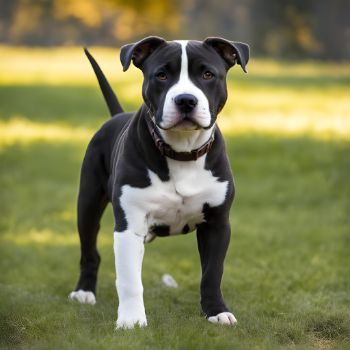
Tri-Color Pitbulls are a unique and beautiful dog breed. They are known for their distinctive coat colors and their friendly personalities.
Muscular Build:
Tri-Color Pitbulls are renowned for their muscular physique. They have a well-defined, athletic build with a broad chest, strong shoulders, and powerful legs. Their shape reflects their strength and agility.
Head Shape: These dogs have a distinctive head shape characterized by a short muzzle and a well-defined jawline.
Their head is proportionate to their body size, and they often have round, expressive eyes.
Ears: Tri-color pit bulls can have either cropped or natural ears. Their ears, when natural, are typically medium-sized and sit high on their head.
The choice of ear cropping is a personal preference and varies among individual dogs.
Tail: Their tail is typically short and tapers to a point. It is carried low and straight, never curled over the back.
Size:
Tri-Color Pitbulls are considered medium-sized dogs. On average, male Tri-Color Pitbulls stand at a shoulder height of about 18 to 21 inches (45 to 53 cm).
At the same time, females are slightly smaller in stature. This size range places them comfortably in the medium category regarding dog sizes.
Weight:
A Tri-Color Pitbull’s weight can change based on its family traits, what it eats, and how much it moves around.
Adult Tri-Color Pitbulls typically weigh between 35 to 60 pounds (16 to 27 kilograms). Males tend to be on the heavier side of this range, while females are generally lighter.
Lifespan:
Like most dogs, Tri-Color Pitbulls have a lifespan that various factors, including genetics, diet, and overall care, can influence.
On average, these dogs usually live for about 10 to 15 years. If you take good care of your Tri-Color Pitbull and ensure they stay healthy and happy, you can look forward to spending many years together as friends.
Tri-Color Pitbull Temperament and Personality:
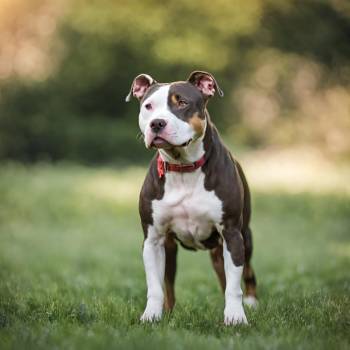
Tri-Color Pitbulls are known for their friendly and affectionate personalities.
Friendly:
Pitbull Tri dogs are known for their friendly and affectionate nature. They often form strong bonds with their human families and can be quite loving. These dogs are renowned for their eagerness to please, making them excellent choices for families seeking a loyal and devoted pet.
Loyal and Protective:
While they may be friendly, Tri-Color Pitbulls are also naturally protective of their loved ones.
They can be watchful and often alert their owners if they sense something amiss. This loyalty and protective instinct make them excellent watchdogs.
Energetic:
Pitbull Tri dogs are energetic and love to play. They are known for their vitality and can be playful, making them great companions for active individuals or families.
Exercising and playing are really important to ensure they stay happy and healthy.
Intelligent and Trainable:
These dogs can quickly grasp commands and training cues. They do well when praised for doing things right and trained in a way that stays the same.
With proper socialization and training, Pitbull Tri dogs can be well-mannered and obedient pets.
Affectionate Cuddlers:
Tri-Color Pitbulls often have a soft side and enjoy cuddling with their human family members.
Because they’re affectionate, they’ll probably want to cuddle with you by sitting on your lap or getting close to you to get your attention.
Adaptable to Living Conditions:
Pitbull Tri dogs can adapt well to different living conditions, whether a spacious suburban home with a backyard or a cozy urban apartment.
They can thrive in various environments if they receive proper exercise and mental stimulation.
Playfulness with Children:
Tri-Color Pitbulls are generally known for their gentle and playful behavior with children.
They are usually calm and understanding, which makes them good friends for families with children. However, supervision is always advisable when any dog interacts with children.
Coat and Color Varieties:
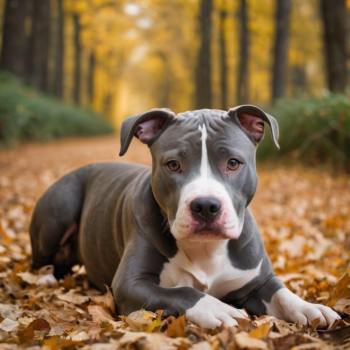
Tri-Color Pitbulls are easily recognized by their distinctive three-color coat patterns. These unique coat variations are intriguing.
Genetic Factors:
A Tri-Color Pitbull’s coat color is primarily determined by genetics.
They inherit these colors from their parents through complex genetic processes. In simple terms, genes decide which colors and patterns appear.
Base Color:
The base color of a Tri-Color Pitbull’s coat is typically white. This white backdrop makes the other two colors, often black and tan, stand out vividly.
Patches and Patterns:
Most Tri-Color Pitbulls have large patches of black and tan on their white coat. These patches come in various sizes and positions, resulting in unique patterns for each dog.
Color Variation:
While black and tan are common, some may have brindle patterns mixed with the tri-color scheme, creating a marbled appearance.
Puppy vs. Adult Coat:
| Coat | Puppy | Adult |
| Texture | Softer and Fluffier | Coarser and More Dense |
| Patterns | Less Defined, May Be Mottled | Clear and Distinct Patterns |
| Color Development | May Change as They Grow | Stabilize as They Mature |
| Coat Care | Easier to Manage in Puppyhood | May Require More Care |
| Coat Maintenance | Occasional Brushing Sufficient | Regular Brushing Recommended |
Do Tri-Color Pitbull Puppies Change Color As They Grow?

Yes, tri-color pitbull puppies can change color as they grow.
Their coat color may become slightly darker or lighter, and the markings may become more or less pronounced.
It is because the pigment cells in their fur are still developing.
As Tri-Color Pitbull puppies grow, their coat colors tend to become more vibrant and distinct.
During puppyhood, what may have appeared as faint patches of black and tan on a white background may develop into more pronounced and striking colors as they reach adulthood.
In some cases, these multi colored pitbulls may exhibit brindle patterns within their coat coloration. These patterns may also become more prominent as they mature.
The combination of genetics and the natural maturation process contributes to these changes.
Remember that each dog in this breed can be different from the others. Some Tri-Color Pitbulls may experience more noticeable changes in coat color than others.
These variations make each dog unique and add to the breed’s charm.
Shedding:

Tri-Color Pitbulls are moderate shedders. It means that they do shed, but not excessively.
Like many other dog breeds, their shedding patterns can vary based on genetics, age, and overall health.
Some Tri-Color Pitbulls may experience increased shedding during seasonal changes.
This shedding is often more noticeable in the spring and fall, when dogs typically shed their winter and summer coats to adapt to changing temperatures.
The short and sleek skin of multi colored pitbulls tends to result in less noticeable shedding compared to dogs with longer or denser fur.
Exercise Needs:
Tricolor Pitbulls” are well-liked because they look cool and friendly. To ensure their well-being and happiness, it’s crucial to understand their exercise requirements and provide them with the physical activity they need.
Daily Exercise Requirement:
Tri-Color Pitbulls are an energetic breed that benefits from daily exercise to maintain physical and mental health.
On average, they require around 30 to 60 minutes of exercise daily. It can mix brisk walks, playtime, and interactive games.
Active Nature:
These dogs have a lively and active nature. They enjoy running, fetching, and engaging in activities that challenge their agility and intelligence.
Regular exercise helps them stay in good shape and stops them from getting bored.
Variety in Exercise:
It’s essential to offer various exercise options to keep your Tri-Color Pitbull engaged and happy. It can include neighborhood walks, dog park trips, or play sessions in a secure backyard.
Keeping your pet’s brain active with puzzle toys and teaching them commands can make them feel happier and healthier.
Age and Individual Differences:
The exercise needs of Tri-Color Pitbulls can vary depending on their age and individual characteristics.
Puppies may have bursts of high energy and require shorter, more frequent playtimes. Older dogs may still enjoy exercise but at a more moderate pace.
Health Benefits:
Regular exercise provides numerous health benefits for Tri-Color Pitbulls. Exercise keeps them at a good weight, strengthens their muscles and joints, and helps their heart stay healthy.
The activity also contributes to their mental alertness and can improve their overall behavior.
Here are some ideas for exercising your Tri-Color Pitbull:
- Go for walks or runs.
- Play fetch or other interactive games.
- Visit a dog park.
- Take them swimming.
- Enroll them in agility or other dog sports.
- Train them new tricks.
Tricolor Pitbull Living Conditions:
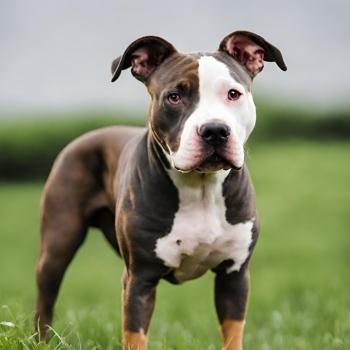
Tricolor Pitbulls can live in various living conditions but do best in homes with yards to run and play.
These dogs like to run around and play often, but they’re also happy to relax on the couch with their family.
Space Requirements:
If they exercise enough, tri-color Pitbulls can adapt well to various living situations, including apartments. However, a house with a secure backyard is often ideal.
The size of your living space matters less than the time and attention you can devote to their exercise and companionship needs.
Indoor Comfort:
Tri-Color Pitbulls are affectionate and enjoy being with their families. They do well when they’re a part of every day’s happenings.
They need a cozy inside place with water and protection from bad weather.
Temperature Considerations:
Tri-color pitbulls can adapt to various temperatures but may be sensitive to extreme heat or cold.
Provide shade and access to water; during cold weather, ensure they have warm shelter.
Tri-Color Pitbull Training:
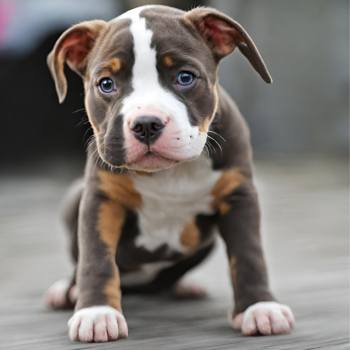
Training a Tri-Color Pitbull can be an enjoyable and rewarding experience for you and your furry friend.
Why Training Matters:
Training helps your Tri-Color Pitbull learn good behavior and become a well-mannered pet.
• Start Early:
Begin training when your Pitbull is a puppy. Dogs are like eager learners who can absorb knowledge easily. But don’t worry if your dog is older; they can still learn.
• Use Positive Reinforcement:
It means rewarding good behavior with treats, praise, or toys. When your Pitbull does something right, tell them they’ve done well.
• Basic Commands:
Begin with easy instructions such as “sit,” “stay,” and “come.” Be patient and repeat the orders consistently.
• Consistency:
Use the same words for commands every time. Saying “sit” one day and “down” the next can confuse your dog.
• Short Sessions:
Keep training sessions short, around 10-15 minutes. Dogs have short attention spans, so shorter sessions work best.
• Socialization:
Introduce your Pitbull to different people, places, and animals. It helps them become friendly and well-adjusted.
• Leash Training:
It is for helping the dog to walk properly without pulling the leash. Use treats to reward them for walking nicely.
• House Training:
To avoid accidents indoors, establish a routine for bathroom breaks and reward your dog when they go outside.
• Patience and Kindness:
If your Pitbull makes a mistake, don’t scold them. Instead, redirect them to the right behavior. Be patient and kind.
• Safety First:
Always keep your Pitbull safe during training. Use a secure leash and collar, and avoid situations that could be risky.
• Practice:
Remember, training is an ongoing process. Keep practicing, and your Tri-Color Pitbull will continue to learn and grow.
Health of Tri-Colored Pitbulls:
Caring for the health of your Tri-Color Pitbull is essential to ensure they live a happy and active life. Let’s explore some straightforward information about keeping your furry friend healthy.
• Regular Vet Visits:
Tri-color pit bulls, like all dogs, need to visit the vet regularly. These visits help the vet check for any health issues and keep your dog up to date on vaccinations.
• Diet and Nutrition:
Feeding your Pitbull a balanced diet is crucial. Good dog food gives your pet everything they need to stay healthy. Always ensure that your dog can drink clean water whenever they want.
• Heartworm Prevention:
Heartworm disease can be a risk for dogs. Please speak to your vet about heartworm prevention options and follow their recommendations.
• Flea and Tick Control:
Fleas and ticks can bother your dog and transmit diseases. Use appropriate flea and tick control methods as advised by your vet.
• Spaying or Neutering:
Spaying (for females) or neutering (for males) your Pitbull can help prevent certain health issues and reduce the risk of unwanted puppies.
• Hydration:
Always ensure your Pitbull has access to clean, fresh water. Dehydration can lead to health problems.
• Observation:
Keep an eye on how your dog acts. Talk to your vet if you see them eating less, being less active, or showing strange signs. Finding problems early is really important for their health.
Taking Care of Your Tri-Color Pitbull: Grooming Tips
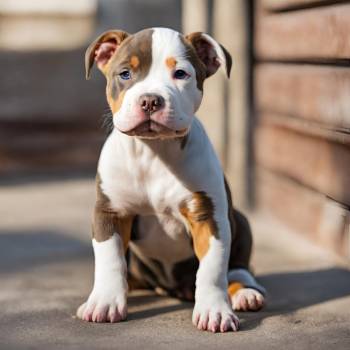
Grooming your Tri-Color Pitbull is essential to keeping them healthy and comfortable.
Let’s go over some simple grooming tips that you can easily follow.
• Brushing:
Regular brushing is important to keep your Pitbull’s coat clean and loose hair-free. Try using a gentle brush or a special glove for pets. Brushing them spreads the oils on their fur, making it look nice and healthy.
• Bathing:
Although Pitbulls don’t require baths often, giving them one when they become dirty or smell bad is a good idea. Wash with a mild shampoo and rinse them completely to remove the soap.
• Ears:
Make sure to look at your dog’s ears often. If you see any dirt or wax inside, softly wipe it away with a damp cloth. Don’t put the fabric too far into the ear.
• Teeth:
Taking care of your Pitbull’s teeth is important for their health. You should brush their teeth often using a special dog toothbrush and toothpaste. Giving them dental treats or toys can also keep their teeth nice and clean.
• Nails:
Trim your pit bull’s nails when needed. Long nails can make them uncomfortable and make it hard for them to walk properly. Use a dog nail clipper, or ask your vet or a groomer for help if you’re unsure.
• Skin and Coat:
Inspect their skin for irritation, redness, or unusual lumps. If you see something strange, talk to your vet. Regular grooming helps you spot these issues early.
• Shedding:
Pitbulls shed, but regular brushing can help manage loose hair. You may need to brush more often during shedding seasons to keep your home clean.
• Eye Care:
Clean any discharge from your Pitbull’s eyes using a damp cloth. Talk to your veterinarian if your pet’s eyes water or turn red.
• Tail:
Pay attention to your dog’s tail area. Please keep it clean and dry to prevent irritation or infection.
• Positive Experience:
Make grooming a positive experience. Use treats and praise to reward your Pitbull for good behavior during grooming sessions. It helps them associate grooming with something enjoyable.
Unique Facts About the Tricolor Pitbull
- Tri-color pitbulls have unique nose prints, just like human fingerprints.
- Their charming smiles are one of their endearing features.
- They possess strong jaws, making them great at play.
- Tri-Color Pitbulls are often excellent therapy dogs, offering comfort to those in need.
- Many of them love water and are skilled swimmers. They excel in various dog sports, showcasing their athleticism.
- Historically bred for work, they maintain a strong work ethic.
- Tri-Color Pitbulls form deep emotional bonds and are incredibly loyal.
- Rehabilitation success stories highlight their potential to thrive in loving homes.
Tri-Color Pitbull Puppies:
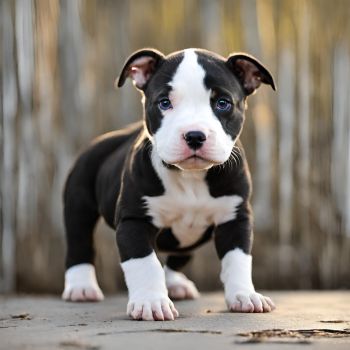
Tri-Color Pitbull puppies are cute and unique. They come in various colors, typically black, tan, and white.
These puppies are known for their playful and friendly nature, making them wonderful family companions.
When you bring a Tri color Pitbull puppy into your home, there are a few important things to remember.
First, like all puppies, they require patience and training.
They are quick learners, so that they can grow into well-behaved adults with consistent training and positive reinforcement.
Puppies need plenty of love, attention, and socialization. Exposing them to different people, animals, and environments from a young age is important to help them become well-mannered adults.
Good food is super important for your puppy to grow and be healthy. High-quality puppy food has all the good stuff they need. Going to the vet regularly is also important.
The vet gives them shots and checks to ensure they stay happy and healthy.
Tri-Color Pitbull puppies are known for their boundless energy and need daily exercise and playtime. It helps them use power and keeps their bodies and minds healthy.
Tri-Color Pitbull Price: How Much Are Tri-Color Pitbulls?
The price of a Tri-Color Pitbull can vary depending on several factors. On average, you can expect to pay between $800 and $2000 for a Tri-Color Pitbull puppy. But, this cost can increase or decrease depending on important factors.
- Established and reputable breeders often charge higher fees for their Tri-Color Pitbull puppies. They invest in the health and quality of their dogs, which can be reflected in the cost.
- Tri-Color Pitbulls with a strong pedigree or lineage of champions tend to be more expensive.
- The specific coat colors and markings can influence the price. Tri-color pitbulls with rarer or more defined patterns may be priced higher.
Older Tri-Color Pitbulls or those with advanced training may have different price points than puppies.
Are They More Expensive Than Other Varieties?
Yes, Tri-Color Pitbulls are generally more expensive than other varieties of Pitbulls. It is because they are relatively rare and they are in high demand.
In some cases, Tri-Color Pitbulls may be priced similarly to different color variations of the breed. In contrast, they might be more expensive in other instances, especially if they have unique or highly desirable coat patterns.
Adopting a Tri-Color Pitbull: Where to Find Them
Adopting a Tri-Color Pitbull is a wonderful decision that can change your and a deserving dog’s lives.
If you’re interested in adopting a Tri-Color Pitbull puppy, there are several places where you can begin your search. Here are some options:
1. Animal Shelters and Rescues:
Many animal shelters and rescue organizations have Tri-Color Pitbull puppies available for adoption. These organizations rescue dogs needing homes and provide them with medical care and love.
2. Breed-Specific Rescues:
Breed-specific rescue groups focus on Pitbulls, including Tri-Color Pitbulls. These groups work hard to find caring families for Pitbulls that need a home.
3. Online Adoption Websites:
Petfinder and Adopt-a-Pet allow you to search for adoptable dogs, including Tri-Color Pitbulls, in your area. You can also search by selecting location and breed.
4. Local Animal Control:
Contact your local animal control or animal services department to inquire about available Pitbull puppies for adoption. They may have information on dogs in need of homes.
5. Pitbull Advocacy Groups:
Some advocacy groups promote responsible Pitbull ownership and may have information on adoptable dogs.
6. Social Media and Networking:
Joining Pitbull-related social media groups and networks can help you connect with individuals with Tri-Color Pitbull puppies available for adoption.
7. Visit Local Shelters:
Visit your local animal shelters and inquire about Tri-Color Pitbull puppies. Sometimes, seeing the dogs in person can help you make a connection.
Here are some additional tips for adopting a Tri-Color Pitbull puppy:
- Be prepared to answer questions about your lifestyle and dog experience.
- Communicate your expectations and what you can offer the dog.
- Meet the puppy several times to build a connection and assess behavior.
- Consider bringing a family member or friend when meeting the puppy.
- If you have doubts about the organization or the puppy, it’s okay to reconsider your decision.
The Level of Experience Needed to Care for a Tri-Color Pitbull
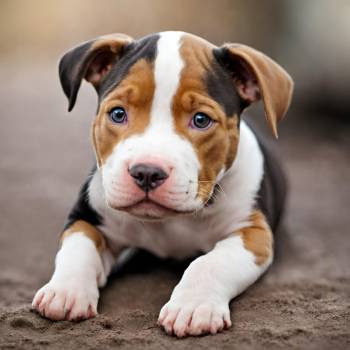
When owning a Tri-Color Pitbull, having prior experience with dogs is helpful but only sometimes necessary. Here’s a simple breakdown of what you might consider:
You likely understand their needs well if you’ve owned and cared for dogs. This experience can be valuable.
If you’re a first-time dog owner, owning a Tri-Color Pitbull is still possible. However, you should be willing to invest time in learning about dog care and training.
Educating yourself about the specific traits and characteristics of Tri-Color Pitbulls is essential.
It is important to know what they’re like and how much they need to move around.
Regardless of your experience level, commitment to training and socializing your Tri-Color Pitbull is vital. Using regular and kind rewards can teach them how to behave better.
Tri-Color Pitbulls thrive on attention and love. Be prepared to dedicate time to exercise, play, and bonding with your furry friend.
Owning any dog comes with financial responsibilities—budget for food, grooming, vet care, and unexpected expenses.
Ensure your home and yard are safe for your Tri-Color Pitbull. Secure fencing and remove hazards to prevent accidents.
8. Patience and Love:
Owning a Tri-Color Pitbull requires patience, love, and a willingness to provide a caring and nurturing environment.
Tricolor Pitbull Before Buying Guide:
- Assess your lifestyle and daily routines for compatibility.
- Ensure a dog-friendly living environment with space and safety.
- Budget for financial responsibilities, including vet care and grooming.
- Check local regulations regarding Pitbull ownership.
- Consider adoption from shelters or reputable breeders if buying.
- Be prepared for a long-term commitment of 10-15 years.
- Discuss the decision with your family members.
Tricolor Pitbull Mix Pros and Cons
If you’re considering adopting a Tricolor Pitbull mix, it’s important to weigh the pros and cons:
Advantages (Pros):
1. Unique Appearance:
Tricolor Pitbull mixes often have striking and unique coat patterns, making them visually appealing.
2. Loyal Companions:
They can be incredibly loyal and loving pets, forming strong bonds with their owners.
3. Protection:
Pitbull mixes can be protective, offering your home and family security.
4. Adaptability:
Many Tricolor Pitbull mixes are adaptable to different living environments, including apartments.
Disadvantages (Cons):
1. Exercise Needs:
They require regular exercise and mental stimulation. If not adequately exercised, they may become restless or display destructive behavior.
2. Training Commitment:
Pitbull mixes need consistent training and socialization to ensure they are well-behaved and comfortable around other animals and people.
3. Breed Stereotypes:
Some people may have misconceptions about pit bulls, leading to prejudice or difficulties in certain neighborhoods or with insurance providers.
4. Legal Restrictions:
Breed-specific legislation can limit ownership or require special permits in some areas.
Quick Coat Color Comparison:
| Color | Description | Unique Features |
|---|---|---|
| Black Tri-color | Black, White, and Tan/Brown | Bold and Striking |
| Blue Tri-color | Steel Blue, White, Tan/Brown | Cool and Distinctive |
| Chocolate Tri-color | Chocolate, White, Tan/Brown | Rich and Warm |
| Lilac Tri-color | Lilac (Diluted Choc.), White, Tan | Exceptionally Rare |
| Purple Tri-color | Purple Hue, White, Tan/Brown | Exquisitely Unique |
| White Tri-color | White, Black, Tan/Brown | Crisp and Contrasting |
| Fawn Tri-color | Fawn (Light Tan), White, Black | Elegant and Balanced |
| Red Tri-color | Red, White, Tan/Brown | Vibrant and Striking |
| Champagne Tri-color | Champagne, White, Tan/Brown | Unique and Elegant |
| Tan Tri-color | Tan, White, Black/Brown | Classic and Timeless |
| Brindle Tri-color | Brindle (Striped), White, Tan | Striking and Distinct |
| Ghost Tri-color | Light Grey/Blue, White, Tan | Subtle and Elegant |
| Grey Tri-color | Grey, White, Tan/Brown | Cool and Distinguished |
| Liver Tri-color | Liver (Brownish-Red), White, Tan | Rare and Rich Liver |
Black Tri-Color Pitbull
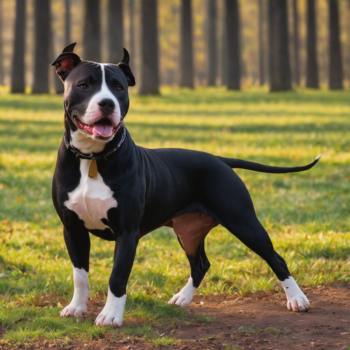
Black Tricolor Pitbulls possess a primarily black coat, making them distinct within the Tri-Color Pitbull category.
What sets them apart are the striking tricolor markings that adorn their black fur.
These markings typically consist of white and brown or tan patches.
The black coat is the dominant color, covering most of the body. It gives these Pitbulls a sleek and elegant appearance.
White patches often appear on their chest, paws, and sometimes on the face. These white accents create a beautiful contrast against the deep black background.
In addition to white, Black Tricolor Pitbulls may also feature brown or tan highlights, usually in patches or spots. These warm tones complement the black and white elements, adding to their unique and eye-catching appearance.
While black is the primary coat color, the specific placement and size of the white and brown/tan patches can vary from one Black Tri colored Pitbull to another. This natural variation adds to the individuality and charm of each dog.
Many people are drawn to the aesthetic appeal of Black Tricolor Pitbulls due to their unique and beautiful coat coloration.
Chocolate Tri-Color Pitbull:

The defining feature of Chocolate Tri color Pitbulls is their rich, chocolate-brown coat color. This deep and warm hue sets them apart from other Tri-Color Pitbull varieties.
Like other Tri-Color Pitbulls, these dogs showcase the tri-color pattern with three primary colors: chocolate brown, white, and a third color.
White usually appears as markings on the chest, paws, and sometimes the face.
The third color in Chocolate Tri-Color Pitbulls can vary. It may be tan, reddish-brown, or even black. It adds individuality and charm to each dog’s appearance.
The rich chocolate color of these Pitbulls is visually striking and often admired by dog enthusiasts. It creates a warm and inviting look that many find appealing.
Their coat is typically short and dense, requiring minimal grooming compared to long-haired breeds.
While their coat color is unique, Chocolate Tri-Color Pitbulls share the same loyal and loving temperament as other Pitbulls. Responsible ownership, training, and socialization are essential for a well-rounded pet.
Purple Tri-Color Pitbull:
A purple tri color Pitbull is a special variation of the tri-color Pitbull breed.
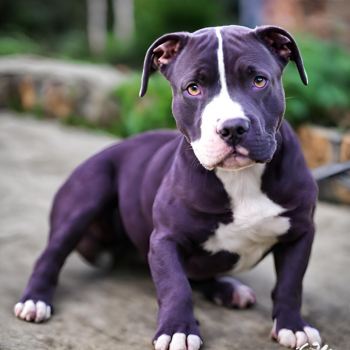
Instead of the traditional tan color, their coat has a purple tint, giving them a one-of-a-kind appearance.
The purple hue on their coat can vary in intensity, ranging from a light lavender to a deeper shade of purple.
This coloration results from a genetic variation that affects the pigmentation in their fur. It’s quite a rare and unique trait among Pitbulls.
However, it’s important to note that “purple” is used more as a descriptive word than a color like red or blue.
The purple Pitbulls still have the black and white markings commonly found in tri-color Pitbulls, but their tan areas have this distinct purple undertone.
Purple Nose Pitbull:
Purple nose Pitbulls are not recognized or standard coat color variations within the Pitbull breed. The term “purple nose” is not a recognized or natural coloration for Pitbulls.
Pitbulls typically come in various coat colors: black, blue, red, brindle, and fawn. Nose color in Pitbulls can also vary, with most having black noses, but some may have blue or liver-colored noses.
Tan Tri-Color Pitbull:

A tan Pitbull is one with a tan base coat and markings of white and black.
The tan markings are typically found on the dog’s face, chest, and legs, while the white markings are often found on the paws and stomach.
The black markings can be found anywhere on the dog’s body.
In addition to the tan, these Pitbulls have black and white markings. The black can appear in patches or stripes, while the white often covers their chest, paws, and sometimes the tip of their tail.
These three colors together create a harmonious and eye-catching blend on their coat.
Tan tri-color Pitbull puppies are especially adorable, with their soft and fluffy fur showcasing these colors as they grow.
As they mature, their coat may become more defined, and the tan, black, and white colors will become more noticeable.
If you’re thinking about bringing a tan Pitbull puppy into your home, it’s important to remember that their coat color is just one aspect of their unique charm.
White Tri-Color Pitbull:
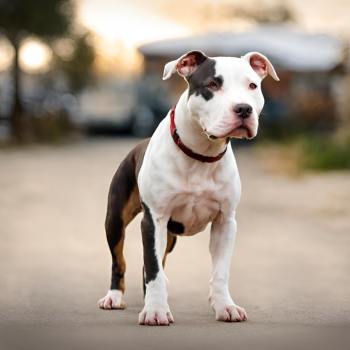
As their name suggests, Tri-color Pitbulls have three distinct colors in their coat.
While these colors typically include black and brown, the third color can vary. In some cases, this third color is white.
White in the coat of a tri-color Pitbull adds a unique and eye-catching element to their appearance. It often appears as patches or markings on their black and brown fur.
These white markings can be found on their chest, paws, face, or other parts of their body.
However, it’s important to note that not all tri-color Pitbulls have white in their coat. Their genetics determine the presence of white in their skin.
Pitbulls with the white coat variation inherit specific genes that cause the white coloration.
Therefore, if you come across a tri-color Pitbull with white in its coat, you can appreciate the beauty of this unique color combination.
Remember that white in their coat is a natural variation and doesn’t affect their personality or behavior.
Champagne Tri-Color Pitbull:
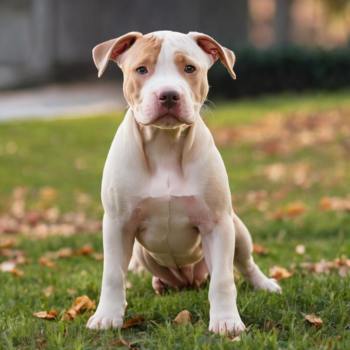
A Champagne Tri-Color Pitbull is a type of Pitbull with a distinctive coat color.
While most tri-color Pitbulls have black, brown, and white in their coat, the champagne variety has a unique twist in coloration.
Instead of the traditional black and brown, their fur is marked by a lighter, almost pale, tan, or beige color, resembling the shade of champagne, which is a type of sparkling wine.
If you see a Champagne Tri Pitbull, you may notice their tan or beige patches or markings on their body.
These patches can be located on their chest, legs, or other parts of their coat. However, not all tri-color Pitbulls have this champagne coloration; their genetic makeup determines it.
It is important to remember that champagne tri-color Pitbulls are a rare color variation of the breed. If you see puppies advertised as champagne tri-color Pitbulls, research them.
Fawn Tri Color Pitbull:
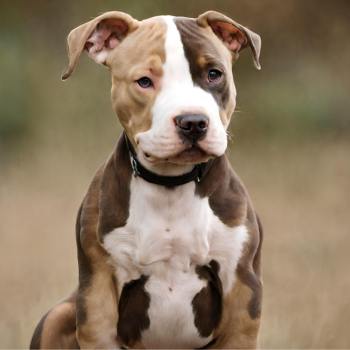
A fawn tri-color Pitbull is a kind of Pitbull dog with three colors in its coat. These colors are mixed to make the dog look special.
One color in the coat of a tri color fawn pitbull is fawn. Fawn is a light yellow-brown color, like the color of a deer.
This color is usually seen on the body of the dog. It makes the dog look warm and friendly.
Another color is blue. Blue is a bit like gray, but not exactly. It’s often found in small spots on the dog’s coat. This color gives the dog a unique and cool appearance.
The third color in the coat is usually white. White can be found on the dog’s belly, chest, paws, and sometimes on its face. It contrasts nicely with the fawn and blue colors, making the dog look more interesting.
However, not all fawn tri-color Pitbulls look the same. The fawn, blue, and white shades vary from dog to dog. Some may have more fawn, while others may have more white or blue.
Therefore, if you see a fawn tri color Pitbull, it looks different from another one.
Fawn tri-color Pitbulls are a special type of Pitbull known for their unique and attractive coat colors. People who love dogs often find them fascinating because of their beautiful combination of fawn, blue, and white colors.
Tri-Color Brindle Pitbull:
A tri-color brindle Pitbull is a kind of Pitbull dog with three colors in its coat, and one of those colors is brindle. Let me explain more about it.
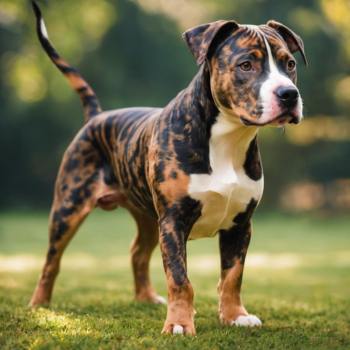
Brindle is a special pattern in the dog’s coat. It looks like wavy stripes or swirls of dark and light colors, like a tiger’s stripes.
The brindle color is often a mix of dark brown or black with lighter shades like fawn or tan. This pattern makes the dog’s fur look interesting and unique.
In addition to the brindle pattern, tri-color brindle Pitbulls have two more colors in their coat. These colors can be white and another color like fawn or blue.
The white parts are usually on the dog’s belly, chest, and sometimes its paws and face.
However, not all tri-color brindle Pitbulls look the same. The shades of brindle, white, and other color can vary from one dog to another.
Some may have more brindle stripes, while others may have more of the different colors. This is why each tri-color brindle Pitbull is special in its way.
Ghost Tri Color Pitbull:
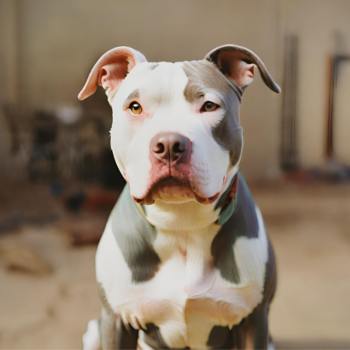
A Ghost Tri colored Pitbull is a relatively rare Pitbull with a tri-color black, silver, and white coat. The silver color is a dilution of black and can give the dog a ghostly appearance.
Sometimes, the black can be a bit like charcoal, and the gray can be silvery. This combination of colors gives them a ghostly appearance, which is why they are called ghost Tri pit bulls.
However, not all Ghost Tri Color Pitbulls look the same. Some may have more black, while others may have more white or gray.
If you see a Ghost Tri Color Pitbull, you might notice that its fur has a pattern. It’s not just one solid color all over. Their coat is like a colorful puzzle, with black, white, and gray pieces fitting together.
Red Tri Color Pitbull:
A Red triangle pitbull typically consists of three main colors: red, black, and white. The base color, red, is dominant and covers most of the dog’s body.
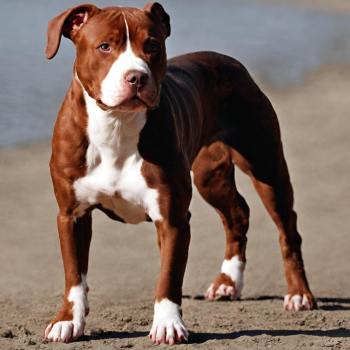
You’ll notice a rich and deep red hue on their coat, giving them a warm and inviting appearance.
However, black and white markings make the Red Tri Color Pitbull even more intriguing. These colors are often distributed across their body in a specific pattern.
You might find black patches, spots, or stripes on their coat, creating a beautiful contrast with the dominant red color.
Therefore, the tri-color combination of red, black, and white gives the Red Tri Color Pit bull a distinctive and eye-catching look.
Notably, these colors’ distribution can vary from dog to dog, making each Red Tri Color Pitbull unique.
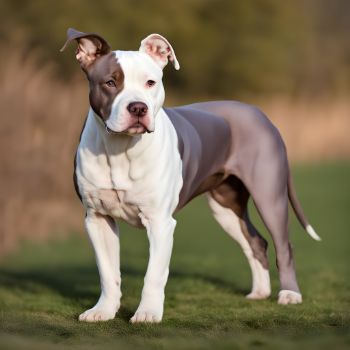
Lilac Tri-Color Pitbull:
The lilac tri Pitbull combines white, black, and a dilute shade of chocolate-brown, often called lilac.
The result is a visually striking and elegant coat pattern.
It occurs when two specific genes interact, diluting the traditional brown to a softer, lavender-like shade.
On average, a lilac tri-color Pitbull can range from $750 to $2000 or more.
Blue Tri Color Pitbull:
The Blue Tri Color Pitbull boasts a remarkable coat that seamlessly blends three distinct colors – white, black, and a striking shade of blue.
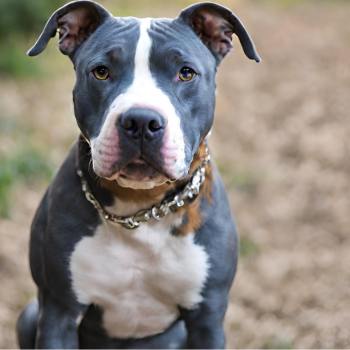
This coloration creates a visually appealing and unique appearance—the blue hue in their coat results from specific genetic factors and responsible breeding practices.
The significance of the blue color in these pit bulls lies in its rarity and beauty.
It is often associated with a desirable and sought-after coat variation, making the Blue Tri Color Pitbull a unique choice for dog enthusiasts.
White and black colors are integrated into the blue base in specific patterns, creating a tri-color effect.
The white markings often appear on the chest, paws, and sometimes the face, contrasting the predominantly blue coat.
Blue Tri Color Pitbull Puppies:
Blue Tri Color Pitbull puppies are born with a clean slate, and their coat colors may fully develop once they are a few weeks old. It is fascinating to watch their blue, black, and white markings become more distinct as they grow.
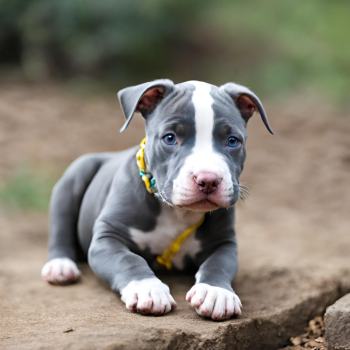
These puppies are known for their friendly and affectionate nature. They tend to be loyal and enjoy being part of a family.
However, like all puppies, they require proper training and socialization to grow into well-behaved adults.
Caring for Blue Tri Color Pitbull puppies is essential to ensure their health and happiness.
They should get regular workouts, eat healthy foods, and visit the vet regularly. Grooming requirements are minimal, making them relatively easy to care for.
They have a lot of energy and will benefit from playtime and walks to keep them happy and fit.
As with any puppy, providing them with a safe and loving environment is crucial. Puppy-proof your home to prevent accidents and offer plenty of toys to engage their curious minds.
How Much does a Blue Tri Pitbull cost?
The cost of a Blue Tri Pitbull varies based on factors like breeder reputation, lineage, age, health, and location. Typically, prices range from $750 or more for a puppy from a reputable breeder.
Adoption from a shelter may offer a more budget-friendly option. Prices can differ due to factors like gender and pedigree. Always research and choose a responsible breeder to ensure the dog’s well-being.
Tri-Color Blue Nose Pitbull:
A Tri-Color Blue Nose Pitbull is a Pitbull with a unique coat featuring three distinct colors, typically including blue as the primary color.
The “blue nose” refers to their nose color, which is often a bluish-gray shade. These dogs look strikingly and are known for their loyalty and affectionate nature.
Grey Tri Color Pitbull:
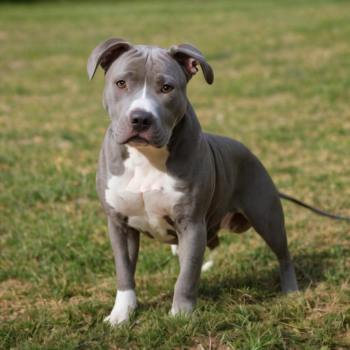
The primary color in a Grey Tri Color Pitbull’s coat is, unsurprisingly, grey. This grey shade can vary from light to dark, creating stunning coat variations.
Their coat’s tri-color pattern typically includes white as the base color, followed by patches of black and grey.
However, it’s important to note that the American Pit Bull Terrier breed standard doesn’t officially recognize grey as a standard color. Therefore, these dogs are often considered a unique and rare variation within the Pit Bull community.
The grey coloration in these dogs is a result of specific genetic factors. While American Pit Bull Terriers typically come in various coat colors, the presence of grey is exceptional.
It’s believed to be influenced by genes that affect pigment production in their hair, resulting in this beautiful and distinctive hue.
However, despite not being officially recognized, Grey Tri Color Pitbulls have gained popularity due to their striking appearance and unique coat.
Their tri-color combination, including grey, black, and white, creates a visually appealing and eye-catching look.
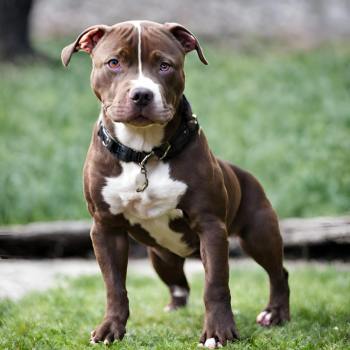
Liver Tri-Color Pitbull:
The Liver Tri-Color Pitbull combines three primary colors: white, black, and a liver-colored hue.
The liver color in these Pitbulls is unique, resembling a rich, reddish-brown shade.
The liver color in these Pitbulls is particularly significant due to its rarity and distinctiveness.
Among tri-color Pit Bulls, the liver variation is less common.
FAQs
When Tri-Color Pitbulls Stop Growing?
Like other Pitbulls, Tri-Color Pitbulls typically stop growing in height between 12 to 18 months.
However, their bodies may continue to fill out and develop muscle until they reach around 2 to 3 years of age.
Are tricolor pitulls Different From Normal Pitbulls?
Tri-Color Pitbulls are not fundamentally different from “normal” Pitbulls. The tri-color aspect refers to their coat pattern, where three distinct colors are present.
Otherwise, they share the same breed characteristics and temperament as other Pitbulls.
Do Kennel Clubs Recognize Tri-Color Pitbull Dogs?
Most kennel clubs, such as the American Kennel Club (AKC) and the United Kennel Club (UKC), do not have specific recognition for coat colors in Pitbulls.
They focus on breed standards, temperament, and health rather than color variations.
What Are Tri-Color Pitbulls Called?
Tri-Color Pitbulls are often called “Tri-Color Pitbulls” due to their distinctive coat pattern, which features three distinct colors.
What Do You Name a Tri-Color Pitbull Puppy?
Choosing a name for your Tri-Color Pitbull puppy is a personal decision. You can pick a name that reflects their unique coat colors or choose a name with a special meaning.
Some popular names for Pitbulls include Max, Bella, Rocky, Luna, and more.
Can Tri-Color Pitbulls Participate in Dog Shows?
Yes, Tri-Color Pitbulls can participate in dog shows, but their eligibility depends on the specific rules and regulations of the show organization.
Typically, the focus is on the dog’s breed standard, behavior, and health rather than their coat color.
What’s the Rarest Pitbull Color?
The concept of rarity in Pitbull colors can be subjective. However, some enthusiasts consider colors like merle or champagne rarer due to the specific genetic combinations required to produce these hues.
Are Tri-Color Pit Bulls the Right Breed for You?
Whether Tri-Color Pit Bulls are the right breed depends on your lifestyle, experience, and preferences. They are known for their loyalty and affection but require responsible ownership, training, and socialization.
Research the breed thoroughly and consider your ability to provide a loving and stable environment before deciding.
Where Does Tri-Color Pitbulls Come From?
Like all Pitbulls, Tri-Color Pitbulls originate from breeding American Pit Bull Terriers.
The tri-color variation results from specific genetic combinations involving three distinct coat colors, typically white and black, and a third color, tan, brown, or grey. Responsible breeders selectively mate dogs to achieve these unique coat patterns.
How to Make a Tri-Color Pitbull?
Creating a Tri Color Pitbull involves selective breeding. Breeders choose parent dogs with the desired coat colors to achieve this variation.
For example, breeding a dog with white, black, and tan markings can produce Tri-Color offspring. Breeders need to prioritize the health and well-being of the dogs in the breeding process.
Can Pitbulls Be Tri Colored?
Yes, Pitbulls can be tri-colored. Tri-Color Pitbulls are a coat variation of the American Pit Bull Terrier breed, characterized by three distinct coat colors.
This unique coloration occurs naturally through specific genetic combinations.
What Two Colors Make a Tri-Color Pitbull?
Tri-color pit bulls typically result from a combination of white and two other colors. For example, a common tri-color variety is white, black, and tan.
The colors can vary, but the tri-color pattern consists of three distinct and well-defined hues in the dog’s coat.
Does Tricolor Pitbulls Make Good Pets?
Yes, Tricolor Pitbulls can make good pets for the right people. Tricolor Pitbull mixes can be wonderful pets if you are prepared for their exercise and training needs and are aware of any legal restrictions in your area.
Their loyalty and unique appearance can make them great companions, but responsible ownership and a commitment to their well-being are essential for a harmonious relationship.
Conclusion:
I hope now you are well aware of tri-color pit bulls. My experience with Tri-color Pitbulls has been truly rewarding. These dogs have left a lasting impression on me with their distinctive coat patterns and loving personalities.
Having shared my life with them, I can attest to their unwavering loyalty and affection. Through my interactions with these remarkable dogs, I appreciate their individuality and the unique bonds they form with their human families.
Their lively behavior makes my day more fun because they’re always up for an exciting adventure or a game of fetch.

